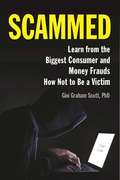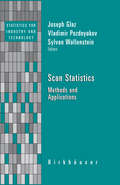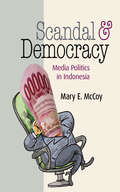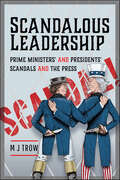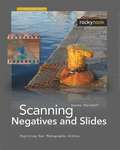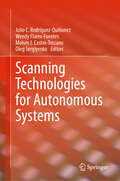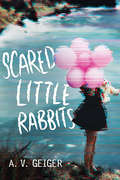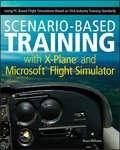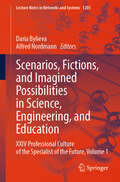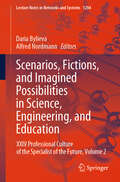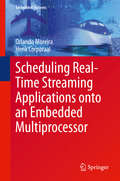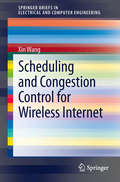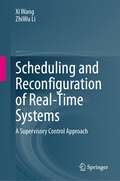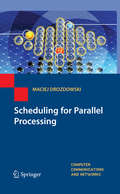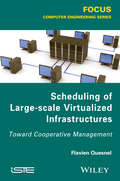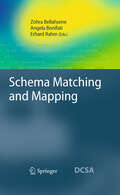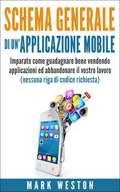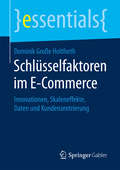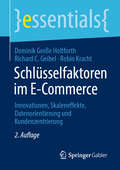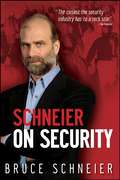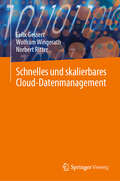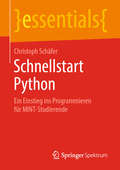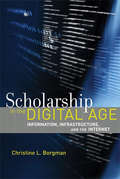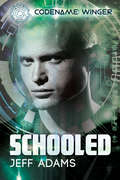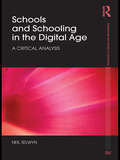- Table View
- List View
Scammed: Learn from the Biggest Consumer and Money Frauds How Not to Be a Victim
by Gini Graham ScottDrawn from the personal experience of dozens of victims, including the author's own encounters, Scammed exposes the most prevalent consumer and money scams lurking in modern society. With so many people falling prey to a wide variety of frauds due to increasing vulnerability on the anonymous Internet, an exposé has never been timelier. This recounts the stories of victims of over two dozen different types of scams, and what they did to recover. <p><p> The chilling tales and details of these scams are interspersed with the wisdom of how each one can be dealt with and avoided. Readers will take away from the shocking stories confidence that they have gained the knowledge and preparedness to avoid being Scammed.
Scan Statistics
by Vladimir Pozdnyakov Joseph Glaz Sylvan WallensteinScan statistics is currently one of the most active and important areas of research in applied probability and statistics, having applications to a wide variety of fields: archaeology, astronomy, bioinformatics, biosurveillance, molecular biology, genetics, computer science, electrical engineering, geography, material sciences, physics, reconnaissance, reliability and quality control, telecommunication, and epidemiology. Filling a gap in the literature, this self-contained volume brings together a collection of selected chapters illustrating the depth and diversity of theory, methods and applications in the area of scan statistics.
Scandal and Democracy: Media Politics in Indonesia
by Mary E. McCoySuccessful transitions to enduring democracy are both difficult and rare. In Scandal and Democracy, Mary E. McCoy explores how newly democratizing nations can avoid reverting to authoritarian solutions in response to the daunting problems brought about by sudden change. The troubled transitions that have derailed democratization in nations worldwide make this problem a major concern for scholars and citizens alike.This study of Indonesia's transition from authoritarian rule sheds light on the fragility not just of democratic transitions but of democracy itself and finds that democratization's durability depends, to a surprising extent, on the role of the media, particularly its airing of political scandal and intraelite conflict. More broadly, Scandal and Democracy examines how the media's use of new freedoms can help ward off a slide into pseudodemocracy or a return to authoritarian rule. As Indonesia marks the twentieth anniversary of its democratic revolution of 1998, it remains among the world's most resilient new democracies and one of the few successful democratic transitions in the Muslim world. McCoy explains the media's central role in this change and corroborates that finding with comparative cases from Mexico, Tunisia, and South Korea, offering counterintuitive insights that help make sense of the success and failure of recent transitions to democracy.
Scandalous Leadership: Prime Ministers' and Presidents' Scandals and the Press
by M. J. TrowAn exploration of the moral blemishes that have dogged the leaders of Great Britain and the United States. Before Britain had a prime minister – and before they invented America – the dictator Oliver Cromwell urged the artist Lely to paint him ‘warts and all’. This book deals with some of the ‘all’, but is mostly about the warts, the moral blemishes that have dogged the leaders of two of the greatest countries on earth for 300 years. Scandalously, there are still no qualifications necessary for the job of prime minister or president, two of the most important positions in the world. And that lack of ability shows itself in spades throughout these pages. Robert Walpole knew that ‘every man has his price’ and bought people accordingly. Viscount Goderich broke down in tears, begging the king to fire him. George Washington, the revered saint of American creation, blew with the wind and owned slaves. Abraham Lincoln was prepared to send African Americans back to Africa to save the Union. William Gladstone popped out from Downing street to ‘save’ prostitutes. David Lloyd George gave people titles for money. Warren Harding had a string of mistresses, as did John Kennedy. And all this happened before Donald Trump! Thank God the fourth estate was there, the free press watching every move of politicians. Who was watching them, of course, is another story. If you thought – and prayed – that the occupants of No. 10 and the White House were honorable, competent people, you’re in for a bit of a shock.
Scanning Negatives and Slides: Digitizing Your Photographic Archive, 2nd Edition
by Sascha Steinhoff<p>Many photographers have either moved into digital photography exclusively or use both analog and digital media in their work. In either case, there is sure to be an archive of slides and negatives that cannot be directly integrated into the new digital workflow, nor can it be archived in a digital format. Increasingly, photographers are trying to bridge this gap with the use of high-performance film scanners. <br/><br/>\nIn this 2nd edition, you will learn how to achieve the best possible digital image from a negative or a slide, and how to build a workflow to make this process efficient, repeatable, and reliable. The author uses Nikon's film scanners, but all steps can easily be accomplished while using a different scanner. The most common software tools for scanning (SilverFast, VueScan, NikonScan) are not only covered extensively in the book, but trial versions are also provided on a DVD, which also contains other useful tools for image editing, as well as numerous sample scans.</p>
Scanning Technologies for Autonomous Systems
by Oleg Sergiyenko Wendy Flores-Fuentes Julio C. Rodríguez-Quiñonez Moises J. Castro-ToscanoThis book provides the theory, methodology, and uses of scanning technologies for the application of autonomous systems. The authors provide readers with an understanding of different technologies and methods to perform scanning technologies and their optimal application depending on the kind of autonomous system. Also, the book presents a compilation of original high-quality contributions and research results from worldwide authors on emerging new autonomous systems based on different scanning technologies. This book is a valuable reference for engineering professionals and the scientific community.
Scared Little Rabbits
by A. V. GeigerWe stand in a tight cluster, high above the lake. One-by-one, we made our way up the narrow trail from the edge of campus. Now, we wait shoulder to shoulder behind the police tape. Nineteen summer students. All but one. <P><P>When Nora gets accepted into her dream summer program at the prestigious Winthrop Academy, she jumps at the chance to put her coding skills to use. But then a fellow student goes missing-and the tech trail for the crime leads back to Nora. Running scared, Nora must race to clear her name and uncover the sordid truth...or she might be the next to disappear.
Scenario-Based Training with X-Plane and Microsoft Flight Simulator
by Bruce WilliamsFly toward pilot certification with these real-world scenario exercises Although PC-based flight simulations have been available for 30 years, many pilots, instructors, and flight schools don't understand how best to use these tools in real-world flight training and pilot proficiency programs. This invaluable reference bridges the gap between simulation tools and real-world situations by presenting hands-on, scenario-based exercises and training tips for the private pilot certificate and instrument rating. As the first of its kind based on FAA-Industry Training Standards (FITS), this book steers its focus on a scenario-based curriculum that emphasizes real-world situations. Experienced pilot and author Bruce Williams ultimately aims to engage the pilot, reinforce the "realistic" selling point of PC-based flight simulations, while also complementing the FAA-approved FITS syllabi. Serves as essential reading for pilots who want to make effective use of simulation in their training while expanding their skill level and enjoyment of flying Covers private pilot real-world scenarios and instrument rating scenarios Includes a guide to recommended websites and other resources Features helpful charts as well as a glossary You'll take off towards pilot certification with this invaluable book by your side.
Scenarios, Fictions, and Imagined Possibilities in Science, Engineering, and Education: XXIV Professional Culture of the Specialist of the Future, Volume 1 (Lecture Notes in Networks and Systems #1203)
by Alfred Nordmann Daria BylievaThis book presents the proceedings of the 24th International Conference Professional Culture of the Specialist of the Future. Professionals and experts in all fields need to be prepared to handle unfamiliar situations. Some of these are unexpected events that may occur quite suddenly out of the blue, and others may emerge in the course of technological development or predicted trends. In order to successfully confront the future, professionals therefore need to engage in hypothetical thinking as they entertain concrete scenarios or fictitious possibilities. Scientists and engineers lead the way when they employ thought experiments and systematically consider alternative realities. Educators come up with creative approaches to foster the “art of the as-if.” This highly interdisciplinary collection of 50 papers discusses the theoretical challenge of hypothetical thinking and presents practical strategies for its promotion.
Scenarios, Fictions, and Imagined Possibilities in Science, Engineering, and Education: XXIV Professional Culture of the Specialist of the Future, Volume 2 (Lecture Notes in Networks and Systems #1204)
by Alfred Nordmann Daria BylievaThis book presents the proceedings of the 24th International Conference Professional Culture of the Specialist of the Future. Professionals and experts in all fields need to be prepared to handle unfamiliar situations. Some of these are unexpected events that may occur quite suddenly out of the blue, and others may emerge in the course of technological development or predicted trends. In order to successfully confront the future, professionals therefore need to engage in hypothetical thinking as they entertain concrete scenarios or fictitious possibilities. Scientists and engineers lead the way when they employ thought experiments and systematically consider alternative realities. Educators come up with creative approaches to foster the “art of the as-if.” This highly interdisciplinary collection of 50 papers discusses the theoretical challenge of hypothetical thinking and presents practical strategies for its promotion.
Scheduling Real-Time Streaming Applications onto an Embedded Multiprocessor
by Orlando Moreira Henk CorporaalThis book provides a comprehensive overview of the state-of-the-art, data flow-based techniques for the analysis, modeling and mapping technologies of concurrent applications on multi-processors The authors present a flow for designing embedded hard/firm real-time multiprocessor streaming applications, based on data flow formalisms, with a particular focus on wireless modem applications. Architectures are described for the design tools and run-time scheduling and resource management of such a platform.
Scheduling and Congestion Control for Wireless Internet
by Xin WangThis brief proposes that the keys to internet cross-layer optimization are the development of non-standard implicit primal-dual solvers for underlying optimization problems, and design of jointly optimal network protocols as decomposition of such solvers. Relying on this novel design-space oriented approach, the author develops joint TCP congestion control and wireless-link scheduling schemes for wireless applications over Internet with centralized and distributed (multi-hop) wireless links. Different from the existing solutions, the proposed schemes can be asynchronously implemented without message passing among network nodes; thus they are readily deployed with current infrastructure. Moreover, global convergence/stability of the proposed schemes to optimal equilibrium is established using the Lyapunov method in the network fluid model. Simulation results are provided to evaluate the proposed schemes in practical networks.
Scheduling and Reconfiguration of Real-Time Systems: A Supervisory Control Approach
by Xi Wang ZhiWu LiThis book presents a methodology for the real-time scheduling problems of real-time systems (RTS) from the viewpoint of control theory. Generally, any system can be viewed as an RTS if it performs real-time application functions and behaves correctly depending on given logical activities and satisfying specified deadlines for the activities. This monograph provides broad views and detailed introductions to supervisory control theory (SCT) and its application in real-time scheduling and reconfiguration. Based on three popular SCT modelling frameworks, discrete-event system (DES), timed DES (TDES), and state-tree structures (STS), the authors provide RTS modelling frameworks; thereafter, SCT is used to find their safe execution sequences. As the main contribution, we use (untimed) DES events to represent the execution and preemption of each individual RTS task. This modelling formalism brings the possibilities to model the preemptions of tasks’ executions. Furthermore, in some cases, priorities cannot be assigned to real-time tasks. In order to solve this problem, a matrix-based priority-free conditional-preemption (PFCP) relation is provided, which generalizes fixed-priority (FP) RTS scheduling. As a natural extension, a generalized modular modelling framework is presented to model the task parameters instead of the global real-time task. The modular models are taken to be generic entities, which also considers the exact execution time of real-time tasks. STS are undoubtedly recognized as a computationally efficient SCT framework which manages the state explosion problem significantly. Hence, building on the (untimed) modular RTS models, a novel STS-based RTS modeling framework is formulated, by assigning dynamic priorities as specified optimality criteria, which can be utilized to model sporadic RTS processing both sporadic and (multi-period) periodic tasks, providing a small set of the safe execution sequences which rank at the top.
Scheduling for Parallel Processing
by Maciej DrozdowskiThis book presents scheduling models for parallel processing, problems defined on the grounds of certain scheduling models, and algorithms solving the scheduling problems. The book also provides helpful generalizations about scheduling models. Features: Introduces the fundamental scheduling concepts; Discusses the technological aspects of scheduling for parallel processing; Presents the notions, concepts, and algorithms that are most immediately applicable in parallel processing; Examines the parallel task model; Outlines the methodology of computational complexity theory and introduces the basic metrics of parallel application performance; Explores scheduling with communication delays; Examines scheduling divisible loads in systems with limited memory, various interconnection types, and cost of usage; Includes detailed illustrations, a bibliography, and a notation section. This text will be valuable for researchers in parallel computing, operating systems, management science, and applied mathematics.
Scheduling of Large-scale Virtualized Infrastructures: Toward Cooperative Management
by Flavien QuesnelSystem virtualization has become increasingly common in distributed systems because of its functionality and convenience for the owners and users of these infrastructures. In Scheduling of Large-scale Virtualized Infrastructures, author Flavien Quesnel examines the management of large-scale virtual infrastructures with an emphasis on scheduling up to 80,000 virtual machines on 8,000 nodes. The text fills a need for updated software managing to meet the increasing size of virtual infrastructures. Virtual machine managers and virtual operators will appreciate this guide to improvement in cooperative software management.
Schema Matching and Mapping
by Erhard Rahm Angela Bonifati Zohra BellahseneSchema Matching and Mapping provides an overview of the ways in which the schema and ontology matching and mapping tools have addressed information systems requirements. Topics include effective methods for matching data, mapping transformation verification, mapping-driven schema evolution and merging.
Schema generale di un’applicazione Mobile
by Alessandro Consorti Mark WestonLa rivoluzione delle app mobile è qui, quindi perché non unirsi e scaricare la tua copia di "Schema generale di un'applicazione Mobile" in questo momento! Avete mai pensato di far soldi attraverso la pubblicazione di un'app? Lo sapevate che chiunque può facilmente ed economicamente farlo ora? Dal momento in cui l'iPhone è apparso sul mercato nel 2007 le applicazioni mobile sono rapidamente diventate la prossima corsa all'oro del mondo della tecnologia. Con la quantità di soldi che sono spesi per telefoni cellulari e applicazioni mobili non è una sorpresa che ci siano nuovi milionari ogni giorno in questo settore. Io non sono qui per dirvi che caricando un'app diventerete ricchi come loro, ma per offrirvi un modo per costruire gradualmente una fonte di reddito passivo. Nel mio libro, Schema generale di un'applicazione Mobile, vi mostro esattamente cosa dovete fare per iniziare a costruire un portafoglio di applicazioni mobile e guadagnare passivamente giorno dopo giorno. Probabilmente avete sentito parlare di Angry Birds o Plants vs Zombies? Questi sono giochi per mobile che hanno avuto un grande successo. Non è tuttavia necessario creare un gioco superstar per fare soldi con le app. Anche la maggior parte delle applicazioni di base ha la possibilità di fare soldi per merito del volume di persone che possiedono un telefono cellulare e scaricano applicazioni. Vi mostrerò come iniziare il vostro impero delle app mobile, sfruttando la leva finanziaria che Internet comporta per avviare un business, sia economico che rapido. Non avete nemmeno bisogno di avere alcuna conoscenza di programmazione. In realtà io sconsiglio a tutti di svolgere qualsiasi tipo di programmazione salvo che non si abbiate una fantastica idea che vi appassiona. Se desiderate un business per fare soldi, allora accettate il mio consiglio, vi farà andare molto più spediti. In poche parole, Vi darò una carrellata su tutto ciò che c'è da sapere per lanci
Schlüsselfaktoren im E-Commerce: Innovationen, Skaleneffekte, Daten und Kundenzentrierung (essentials)
by Dominik Große HoltforthDas essential zeigt, wie digitale Innovationen, Customer Centricity, Skaleneffekte und Data Driven Marketing zu nachhaltigen Kundenbeziehungen und Wettbewerbsvorteilen im E-Commerce führen. Dazu werden die vier Schlüsselfaktoren im E-Commerce umfassend dargestellt. Leser und Leserinnen erhalten grundlegende Impulse für die Neuausrichtung von Geschäftsmodellen, zur Gestaltung von Wachstumsprozessen und zur Erzielung nachhaltiger Erträge. Das essential geht dabei über die übliche Auflistung von operativen To-dos hinaus und zeigt Faktoren auf, die digitalen Technologien und E-Commerce zu disruptiver Wirkung verhelfen.
Schlüsselfaktoren im E-Commerce: Innovationen, Skaleneffekte, Datenorientierung und Kundenzentrierung (essentials)
by Dominik Große Holtforth Richard C. Geibel Robin KrachtDas essential zeigt, wie digitale Innovationen, Customer Centricity, Skaleneffekte und Data Driven Marketing zu nachhaltigen Kundenbeziehungen und Wettbewerbsvorteilen im E-Commerce führen. Dazu werden die vier Schlüsselfaktoren im E-Commerce umfassend dargestellt. Leser und Leserinnen erhalten grundlegende Impulse für die Neuausrichtung von Geschäftsmodellen, zur Gestaltung von Wachstumsprozessen und zur Erzielung nachhaltiger Erträge. Das essential geht dabei über die übliche Auflistung von operativen To-dos hinaus und zeigt Faktoren auf, die digitalen Technologien und E-Commerce zu disruptiver Wirkung verhelfen.
Schneier on Security
by Bruce SchneierPresenting invaluable advice from the world?s most famous computer security expert, this intensely readable collection features some of the most insightful and informative coverage of the strengths and weaknesses of computer security and the price people pay -- figuratively and literally -- when security fails. Discussing the issues surrounding things such as airplanes, passports, voting machines, ID cards, cameras, passwords, Internet banking, sporting events, computers, and castles, this book is a must-read for anyone who values security at any level -- business, technical, or personal.
Schnelles und skalierbares Cloud-Datenmanagement
by Wolfram Wingerath Norbert Ritter Felix GessertDie enorme Datenmenge erfordert skalierbare Datenverwaltung für weltweiten Zugriff. Zahlreiche NoSQL-Systeme prägen die komplexe Landschaft. Dieses Buch bietet Überblick und Klassifikation im Cloud-Datenmanagement. Themen umfassen NoSQL-Speichersysteme, polyglotte Architekturen, verteilte Transaktionen, Web-Caching, Datenzugriff und Rendering-Performance. Die Klassifikation ermöglicht eine Betrachtung des Gesamtentwurfs und der Positionen jedes Systems. Ein anwendungsorientiertes Entscheidungshilfetool erleichtert die Auswahl geeigneter Systemkandidaten für bestimmte Anwendungsszenarien.
Schnellstart Python: Ein Einstieg ins Programmieren für MINT-Studierende (essentials)
by Christoph SchäferChristoph Schäfer stellt die großartige Welt der Programmierung mit Python vor und ermöglicht einen schnellen Einstieg zur eigenständigen Entwicklung von Skripten. Er verweist darauf, wie die Programmiersprache Python sich in den letzten Jahren neben MATLAB und R als Standard an naturwissenschaftlichen Arbeitsplätzen in Forschung und Entwicklung etabliert hat, und zeigt, dass die große Popularität von Python sich in der leichten Erweiterbarkeit begründet: So lassen sich sehr einfach Module von anderen Entwicklern in eigenen Skripten und Programmen verwenden. Der Autor stellt insbesondere die Module NumPy, SciPy und Matplotlib vor, die Naturwissenschaftlern und Ingenieuren eine perfekte Entwicklungsumgebung für Wissenschaftliches und Technisches Rechnen, für Anwendungen in der Physik, Chemie, Biologie und Informatik bieten. Auch in den neuesten Applikationen in den hochaktuellen Gebieten Big Data Science und Machine Learning kommt Python zum Einsatz.Der Autor: Dr. Christoph Schäfer lehrt und forscht in der Abteilung Computational Physics am Institut für Astronomie und Astrophysik an der Eberhard Karls Universität Tübingen.
Scholarship in the Digital Age: Information, Infrastructure, and the Internet (The\mit Press Ser.)
by Christine L. BorgmanAn exploration of the technical, social, legal, and economic aspects of the scholarly infrastructure needed to support research activities in all fields in the twenty-first century.Scholars in all fields now have access to an unprecedented wealth of online information, tools, and services. The Internet lies at the core of an information infrastructure for distributed, data-intensive, and collaborative research. Although much attention has been paid to the new technologies making this possible, from digitized books to sensor networks, it is the underlying social and policy changes that will have the most lasting effect on the scholarly enterprise. In Scholarship in the Digital Age, Christine Borgman explores the technical, social, legal, and economic aspects of the kind of infrastructure that we should be building for scholarly research in the twenty-first century.Borgman describes the roles that information technology plays at every stage in the life cycle of a research project and contrasts these new capabilities with the relatively stable system of scholarly communication, which remains based on publishing in journals, books, and conference proceedings. No framework for the impending “data deluge” exists comparable to that for publishing. Analyzing scholarly practices in the sciences, social sciences, and humanities, Borgman compares each discipline's approach to infrastructure issues. In the process, she challenges the many stakeholders in the scholarly infrastructure—scholars, publishers, libraries, funding agencies, and others—to look beyond their own domains to address the interaction of technical, legal, economic, social, political, and disciplinary concerns. Scholarship in the Digital Age will provoke a stimulating conversation among all who depend on a rich and robust scholarly environment.
Schooled (Codename: Winger #2)
by Jeff AdamsTheo Reese is a high school student who’s also a secret agent. Usually those lives are kept separate, but now he must be both at once. <p><p> Theo lends his expertise to his school’s computer science club as they gear up for a competition, but his talents are also required by the covert agency he works for. Someone has stolen an encrypted key that can allow them to control the nation’s energy grids. The possibilities are catastrophic unless Theo and his team can reclaim the file. <p> Theo locates the file in an unexpected place—the computer science competition. As Winger, his secret identity, he must recover the file and keep his teammates safe from the unscrupulous thieves…. But can he do it without revealing his secrets? He can’t blow his cover, especially with so many of his classmates around.
Schools and Schooling in the Digital Age: A Critical Analysis (Foundations and Futures of Education)
by Neil SelwynThis book presents a wide-ranging and critical exploration of a topic that lies at the heart of contemporary education. The use of digital technology is now a key feature of schools and schooling around the world. Yet despite its prominence, technology use continues to be an area of education that rarely receives sustained critical attention and thought, especially from those people who are most involved and affected by it. Technology tends to be something that many teachers, learners, parents, policy-makers and even academics approach as a routine rather than reflective matter. Tackling the wider picture, addressing the social, cultural, economic, political and commercial aspects of schools and schooling in the digital age, this book offers to make sense of what happens, and what does not happen, when the digital and the educational come together in the guise of schools technology. In particular, the book examines contemporary schooling in terms of social justice, equality and participatory democracy. Seeking to re-politicise an increasingly depoliticised area of educational debate and analysis, setting out to challenge the many contradictions that characterise the field of education technology today, the author concludes by suggesting what forms schools and schooling in the digital age could, and should, take. This is the perfect volume for anyone interested in the application and use of technology in education, as well as the education policy and politics that surround it; many will also find its innovative proposals for technology use an inspiration for their own teaching and learning.
